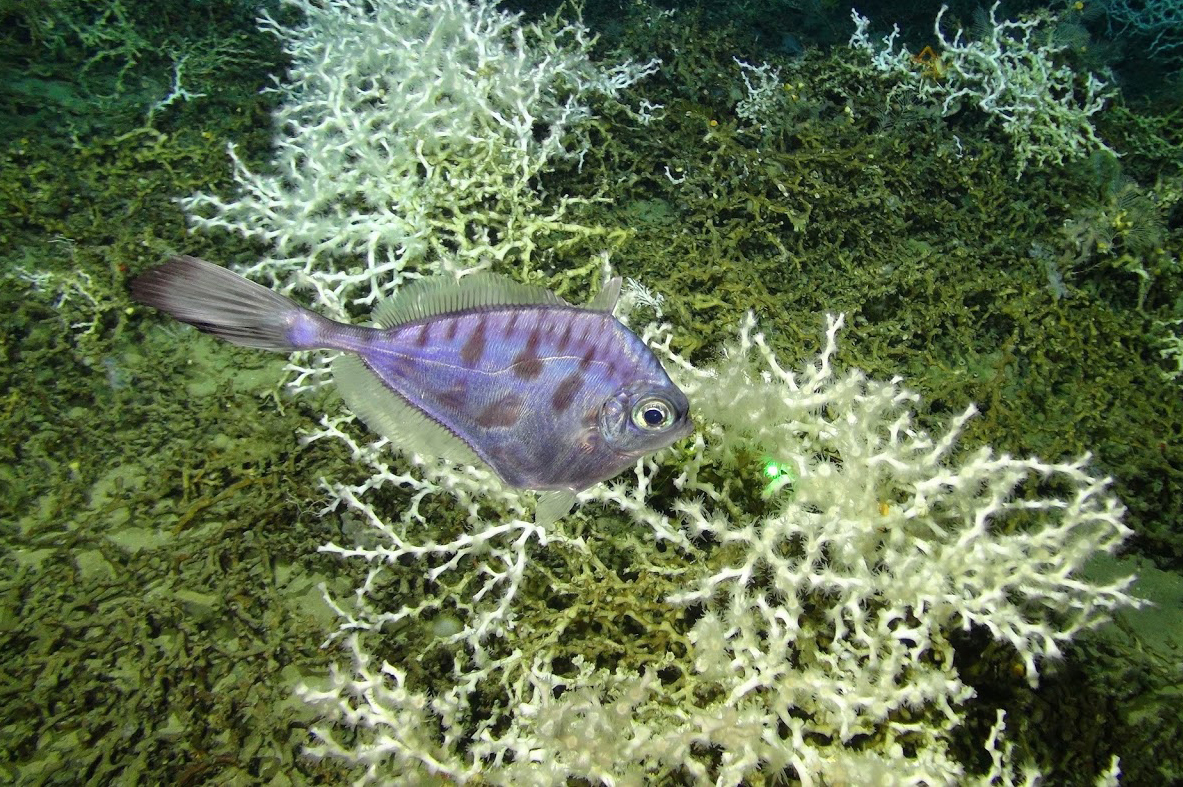- Classification
- ACTINOPTERYGII
- ZEIFORMES
- GRAMMICOLEPIDIDAE
- Grammicolepis
- brachiusculus
Thorny Tinselfish, Grammicolepis brachiusculus Poey 1873

A Thorny Tinselfish, Grammicolepis brachiusculus, swimming above Lophelia pertusa on the West Florida Slope, Atlantic Ocean, 2017, depth 496m. Source: SEDCI-supported expedition aboard NOAA Ship Nancy Foster . License: Public Domain
Silvery fishes with highly compressed deep bodies covered in vertically-elongated scales. Thorny tinselfishes have tiny mouths, enlarged spiny scales along the dorsal and anal-fin bases, and several large spiny scutes on the sides that disappear with growth.
Juveniles are deeper-bodied than adults, and have enlarged, horizontally flattened bony scutes, and a very long branched filament trailing from the first anal-fin spine.
Thorny Tinselfish, Grammicolepis brachiusculus Poey 1873
More Info
|
Distribution |
Off the Houtman Abrolhos to the Northwest Shelf, Western Australia, and the Fraser Seamount in the Coral Sea, Queensland, to off northwest Tasmania; also the Cocos (Keeling) Islands area in the eastern Indian Ocean, and off Lord Howe Island and elsewhere on the Lord Howe Rise, and the Norfolk Ridge in the Tasman Sea. Elsewhere the species is circumglobal in tropical and temperate waters except for the Eastern Pacific. Thorny tinselfishes are benthopelagic around seamounts, ridges and rises. Worldwide, they have been recorded from depths of 300-1025 m. In Australian waters, they are known from depths of 350-865 m. |
|
Features |
Dorsal fin VI-VII, 32-34; Anal fin II, 33-35; Caudal fin 13 + 2; Pectoral fin 15; Pelvic fin I, 6; Gill rakers 14-15 (rudimentary). Body deep, very compressed; head small, eye large, mouth tiny; body covered in vertically-elongate scales, and large spiny scales along bases of the dorsal and anal fins. Juveniles and subadults have large, horizontally flattened scutes on the body sides - scutes become relatively smaller and less obvious with growth. |
|
Size |
To 64 cm total length |
|
Colour |
Juveniles: body silver, or bluish- to purplish-silver with irregular dark blotches on the body and caudal fin; 5 black bars on the anal fin; spiny scutes dark. Adults: dull silver to silvery-blue or purple, with indistinct darker and/or lighter markings on the body and caudal fin; iris golden. |
|
Feeding |
Feeds on small deep-sea crustaceans. |
|
Biology |
Very little is known of the biology of this species. |
|
Fisheries |
Of no interest to fisheries, although the species is taken as by-catch in commercial trawls, lines and deep gill nets. |
|
Conservation |
|
|
Remarks |
In October 2022, the species was filmed by an ROV in Australia's Cocos (Keeling) Islands territorial waters in the eastern Indian Ocean.. |
|
Similar Species |
Differs from the Spotted Tinselfish, Xenolepidichthys dalgleishi, in having large spiny or thorny scutes scattered on the sides (scutes are reduced and low in adults), and fewer dorsal-fin spines (32-35 vs 39-41). |
|
Etymology |
The specific name brachiusculus is from the Latin brachium (= arm, limb) and the suffix -culus, in reference to the short, rounded pectoral fins of this species. |
|
Species Citation |
Grammicolepis brachiusculus Poey, 1873, Anal. Socied. Españ. Hist. Nat. 2: 403. Type locality: Havana, Cuba. |
|
Author |
Bray, D.J. 2022 |
|
Resources |









